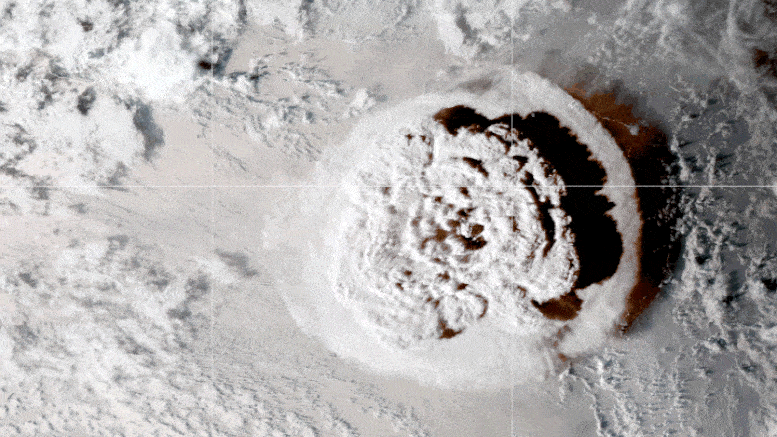The eruption of the undersea Hunga Tonga-Hunga Ha’apai volcano from earlier this year sent so much water vapor into the atmosphere that it’s likely to temporarily warm the Earth’s surface, according to observations by a NASA satellite. This temporary blip won’t significantly impact our planet’s climate, but it shows how massive the eruption truly was.

The volcano erupted on January 15, about 40 miles (65 kilometers) north of Tonga’s capital (over 4000 km east of the coast of Australia), creating a tsunami and a sonic boom that rippled around the world twice. The eruption sent a plume of water vapor into the stratosphere, a layer of the atmosphere, with enough water to fill 58,000 Olympic-sized swimming pools, according to NASA.
The phenomenon was massive that it was detected by the Microwave Limb Sounder (MLS) instrument on NASA’s Aura satellite, which measures ozone, water vapor, and other atmospheric gases. The scientists estimate that the eruption sent 146 teragrams of water to the stratosphere. This is equal to about 10% of the water already present in the layer of the atmosphere.
“We’ve never seen anything like it,” Luis Millán, an atmospheric scientist at NASA’s Jet Propulsion Laboratory in Southern California, said in a statement. Millán led a research looking at the amount of water vapor sent by the volcano. “We had to carefully inspect all the measurements in the plume to make sure they were trustworthy,” he added.
A massive eruption
Volcanic eruptions rarely release that much water. NASA started taking measurements 18 years ago, and since then only two other eruptions (the 2008 Kasatochi event in Alaska and the 2015 Calbuco eruption in Chile) sent significant amounts of water vapor. But those don’t come close to the Tonga event, and the water vapor dissipated quickly.
In general, water makes volcano eruptions more explosive, so you’d expect an explosive event like Tonga to have a lot of water, but even so, it was surprising to see just how much water the eruption spewed into the atmosphere. In this case, it wasn’t just the water from the volcano itself that researchers detected, but water from the ocean around the volcano that was vaporized.
It usually takes between two and three years for the aerosols from volcanos to drop from the stratosphere. But the water from the Tonga eruption could take between five and ten years to dissipate, according to the researchers. Given that timeframe and the amount of water, it would be the first recorded volcanic eruption to impact climate through surface warming.
The planet has already warmed by 1.1 degrees Celsius since the start of the industrial revolution and is set to keep warming. Fortunately, the effect of the water vapor from the volcano is expected to be small and temporary, and shouldn’t accentuate our climate problems.
The authors of the new study also explain that the main reason for the massive amount of water vapor was the depth of the volcano’s caldera: 150 meters (490 feet) below the surface. If it was too shallow, the amount of seawater heated by the magma wouldn’t have matched what reached the stratosphere, and if it was too deep, the depth of the ocean would have limited the eruption.
The MLS instrument was used to detect water vapor because of its capacity to observe natural microwave signals released from the atmosphere. By measuring these signals, the MLS can see through obstacles like ash clouds that can blind other instruments and focus on the water vapor. For Millán, it was “the only instrument” dense enough coverage to capture the water vapor plume, and it’s a good tool to help us understand extreme events like the Tonga eruption.
The study was published in the journal Geophysical Research Letters.
Was this helpful?



